Key Findings and Effects
What teacher can make children feel themselves good and successful? What personality characteristics are behind their communication style with students? What is needed for the development and psychological well-being of a teacher?
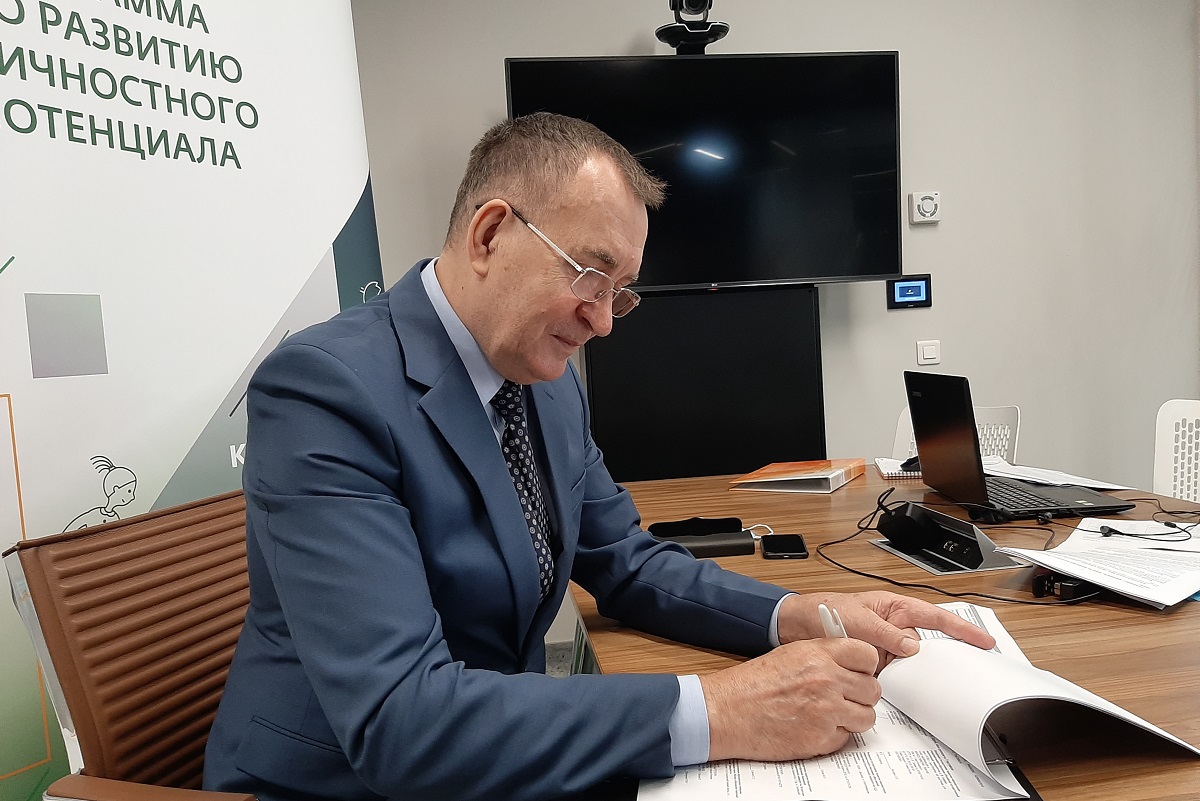 Peter Polozhevets, Executive Director of Sberbank's 'Investment in the Future" Charitable Foundation
Peter Polozhevets, Executive Director of Sberbank's 'Investment in the Future" Charitable FoundationFrom 2018 to 2023, over 2,500 teachers from 30 Russia's regions and over 4,000 schoolchildren took part in the Program's longitudinal studies. We would like to present to you the impact and the results we discovered searching for answers to these questions.
Summary
The data accumulated over the six years when the Program has been implemented make it possible to draw several conclusions that will be useful for achieving practical results:
-
The psychological well-being of a child cannot be promoted without paying attention to the psychological well-being of a teacher. It is important that school administrations adhere to the same principles when working with teachers as teachers working with their students.
-
The personality development of a child requires a mature personality of an adult. Social and emotional development and development of personality potential of schoolchildren begins with the professional and personality development of managers and teachers, their style of interaction with others.
-
A teaching style is the main source of motivation for students during a lesson. Personality characteristics of a teacher predict their communication style.
-
A person's skills and knowledge are important, but more important is their personality potential allowing to congruently apply these skills and navigate in a complex and unpredictable world.
-
Educators’ well-being and engagement are higher if they are a part of a professional learning community.
- A comprehensive approach to changing the culture of an education provider and the personality development of all its participants is more effective than awareness-raising activities or highly specialized programs. At the same time, such a set of actions cannot be the same for all - it is necessary to factor in the specifics of education providers. A conscious choice of development priorities made by the teaching team will be optimal.
A teaching style is the main source of motivation for students during a lesson
According to the self-determination theory, children’s motivation, engagement, well-being and development depend on how their basic psychological needs for autonomy, competence and relatedness are met. The extent to which a teacher can meet these basic needs of children, determines the style of teaching.
Motivating teaching styles that contribute to satisfying basic psychological needs are:
- Autonomy Support
A teacher understands and builds upon the children’s interests, preferences, relationships, to maintain their engagement in learning activities. - Structure
A teacher as a mentor for students. Taking into account their abilities, a teacher explains what is expected of them and how to act to master the material, offering help and support.
Demotivating styles of teaching include:
- Control
A teacher uses pressure and dominance – does not care about the students’ opinions and tries to make them think, behave and treat everything just like he/she thinks fit. - Chaos
A teacher turns away from the children considering them autonomous. This style confuses students, who need to understand what to do and how to develop their skills.
A teacher’s personality predicts their style of communication with students
Our research shows that educators with high personality potential tend to use motivating styles of communicating with students.
Personality potential means those personality characteristics that enable a person to be autonomous, not to be only guided by internal impulses or external pressures, achieve their own goals and maintain the efficiency of their activities.
A correlation analysis on a sample of 1,178 teachers showed that Autonomy Support and Structure styles are associated with 3 substructures of personality potential – the potential of choice, the potential of achievement and the potential of preservation:
- with reflection, tolerance for uncertainty, and responsibility - in the potential of choice;
-
with professional self-efficacy, growth and fixed mindset, and professional motivation - in the potential of achievement;
-
with hardiness - in the potential of preservation.
A teacher's personality potential predicts their style of communication with students
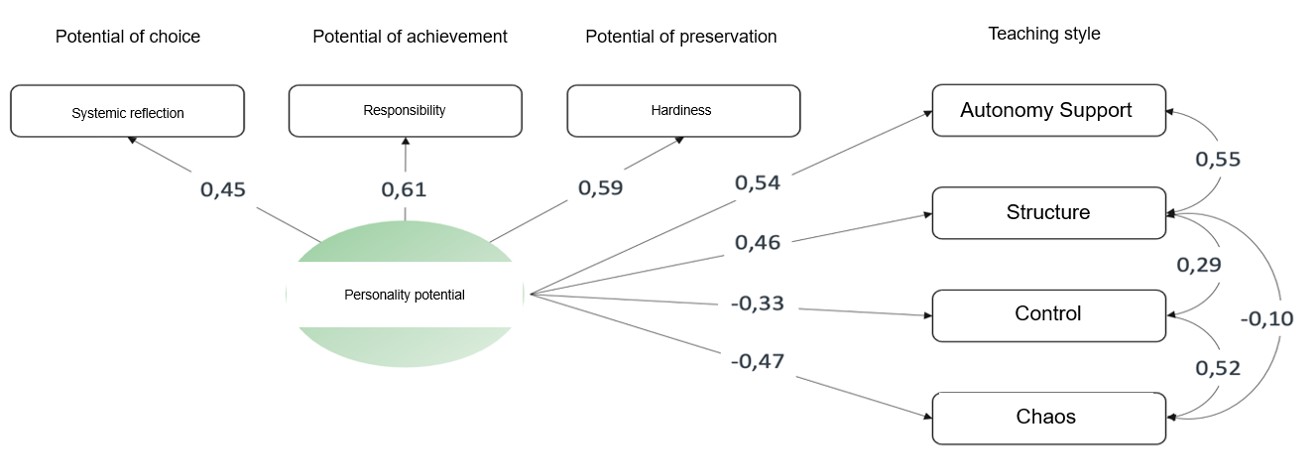
The first impact in the dynamics of personality potential indicators of a teacher can be seen after a year of participation in the Program.
The dynamics of personality potential indicators of teachers has been recorded annually for three years. Statistical significance of differences in mean scores at the initial and subsequent stages of diagnostics is estimated.
Our research shows that many characteristics of educators’ personality potential can be changed. Teachers who complete training under the Program become more resilient and reflective, rethink their attitudes towards the possibility of intellectual development – both their own and children's, work more meaningfully and strive to maintain the autonomy of students.
The personality potential of a teacher is associated with the social and emotional development of younger schoolchildren
Teachers recognize the important role that a school plays in the social and emotional development of a child. However, this requires the teacher to have a mature personality.
Our research shows that there is a correlation between teachers’ personality characteristics and communication styles with social and emotional skills such as Managing Emotions, Working with Others, and Achieving Goals, the strongest link is with the latter.
|
Negative correlation |
Teacher's personality characteristics |
Positive correlation |
||
|
Tolerance of uncertainty |
||||
|
|
|
(general / attitude to complex tasks) |
|
|
|
Hardiness |
||||
|
|
|
General hardiness |
|
|
|
|
|
Commitment |
|
|
|
|
|
Control |
|
|
|
|
|
Challenge |
|
|
|
Person's life stance |
||||
|
|
|
Harmony |
|
|
|
|
|
Mindfulness |
|
|
|
|
|
Agency |
|
|
|
Implicit theories of intelligence |
||||
|
|
|
Fixed mindset |
|
|
|
|
|
Growth mindset |
|
|
|
Professional motivation |
||||
|
|
|
Intrinsic |
|
|
|
|
|
Identified |
|
|
|
|
|
Motivation of self-respect |
|
|
|
|
|
Introjected (guilt-based) |
|
|
|
|
|
Extrinsic |
|
|
|
|
|
Amotivation |
|
|
|
Teaching style |
||||
|
|
|
Engaged |
|
|
|
|
|
Adapting |
|
|
|
|
|
Directing |
|
|
|
|
|
Explaining |
|
|
|
|
|
Demanding |
|
|
|
|
|
Despotic |
|
|
|
|
|
Detached |
|
|
|
|
|
Expecting |
|
|
|
0.01 |
0.05 |
|
0.05 |
0.01 |
2020 survey results. Sample: N= 1,966 schoolchildren (900 1st-graders and 1,066 2nd-graders), 87 teachers. Significance levels: p < 0.01 and p < 0.05
Teacher's communication style is interconnected with psychological well-being and academic motivation in adolescents
Studying 8th-grade students, we found that teachers’ communication styles that support students’ basic needs promote their interest in learning (intrinsic motivation) and reduce the intensity of extrinsic motivation and amotivation.
The correlation between the teacher's communication style and the academic motivation of adolescents
|
Teachers' communication styles |
Types of motivation |
||
|
Intrinsic motivation |
Extrinsic motivation |
Amotivation |
|
|
Autonomy Support |
+ |
|
|
|
Structure |
+ |
– |
– |
|
Control |
– |
+ |
+ |
|
Chaos |
– |
|
+ |
Sample: N= 1,724 8th-graders from 69 schools in 24 regions of Russia. Plus means a positive correlation, minus means negative correlation
Unlike chaotic and controlling communication styles, structuring and autonomy supporting styles of teaching positively correlate with children’s satisfaction with school, relations with teachers, and themselves. The structuring style is also important for developing a child’s normal self-respect.
The correlation between teachers' communication styles and psychological well-being of schoolchildren
|
Teachers' communication styles |
Satisfaction with school |
Satisfaction with relationships with teachers |
Self-satisfaction |
Meeting of basic psychological needs |
Competence-based self-respect |
Compensatory self-respect |
|
Autonomy Support |
+ |
+ |
+ |
+ |
|
+ |
|
Structure |
+ |
+ |
+ |
+ |
+ |
– |
|
Control |
– |
– |
|
– |
|
+ |
|
Chaos |
– |
– |
– |
– |
– |
+ |
Sample: N= 1,724 8th-graders from 69 schools in 24 regions of Russia. Plus means a positive correlation, minus means negative correlation
The key to a teacher’s well-being is membership in a professional community
Teachers striving to support students’ psychological needs, shall have their own needs to be met in school as well. When teachers feel related to their colleagues, they are more engaged with working activities, satisfied with their work and have a higher rate of psychological health [2]. Moreover, our research has shown that as professional learning communities are established and teachers are included in them, their social well-being improves.
Increased teachers’ social well-being

Sample: N=1,599 teachers at the input diagnostics stage and 493 teachers who completed diagnostics after one year of participation in the Program (2019-2023).
Significance level: p = 0.04.
How do the children participates in the Program change?
- Development of social and emotional skills in younger schoolchildren
Social and Emotional Development of Children in Primary School learning kit (SED kit) was developed and is used as part of the Program. According to research, during two years of schooling, children from both the experimental and control groups develop the skills 'Achieving Goals' and 'Working with Others.' However, only those children who were taught using the SED kit showed a significant development of the 'Managing emotions' skill.
Development of social and emotional skills in younger schoolchildren in 2021-2023
Experimental group
Statistical Significance
Control group
Statistical Significance
2021
2023
2021
2023
Achieving goals
Mean
3.54
4.04
Significant
3.70
3.88
Significant
Working with others
3.51
3.90
Significant
3.61
3.82
Significant
Managing emotions
3.64
4.05
Significant
3.83
3.93
Non-significant
Results of the preliminary study (2021) and the final study (2023). Sample: N= 859 students from 19 schools in 12 regions of Russia. Out of whom:
- 593 students from the experimental group who were taught using SED kit
- 266 students from the control group who did not use the SED kit
Our own research shows that even one-third of the classes prescribed by the SED kit promote the development of all three skills.
- Building universal competencies
Our research found that a creative environment – offering opportunities for freedom and initiative to a child – is the best for building universal competencies, such as critical thinking, creativity, communication, and cooperation, in middle school students [10,11].
The correlation between these competencies and the degree of environment's activity – the opportunities it gives children to take initiative and persevere in something [16] – appeared most significant.
According to our research, schoolchildren whose teachers have completed advanced training courses as part of the Program and designed special classes have more positive dynamics in creativity [8] and critical thinking.
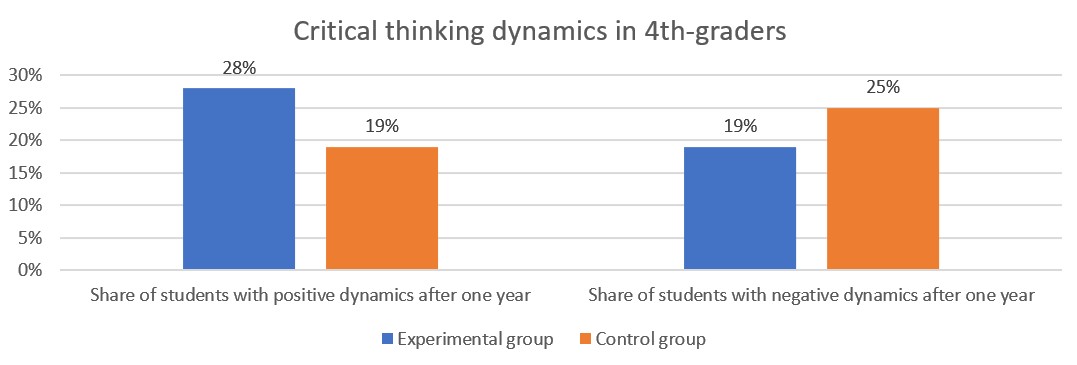
Results of a study carried out in the autumn'2020 – spring'2021 at schools in Yaroslavl Oblast (Russia). Sample: N=409 4th-graders (210 – from experimental group, 199 – from the control group)
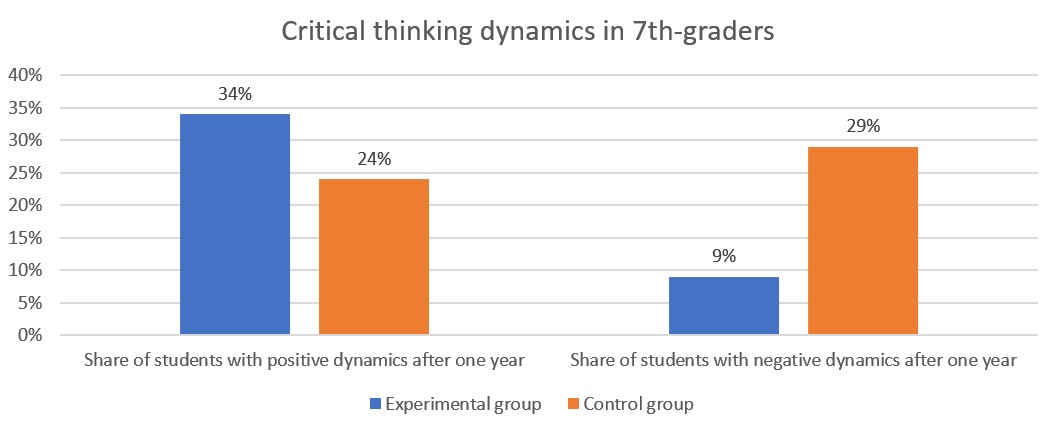
Results of a study carried out in the autumn'2020 – spring'2021 at schools in Yaroslavl Oblast. Sample: N=174 4th-graders (56 – from experimental group, 118 – from the control group)
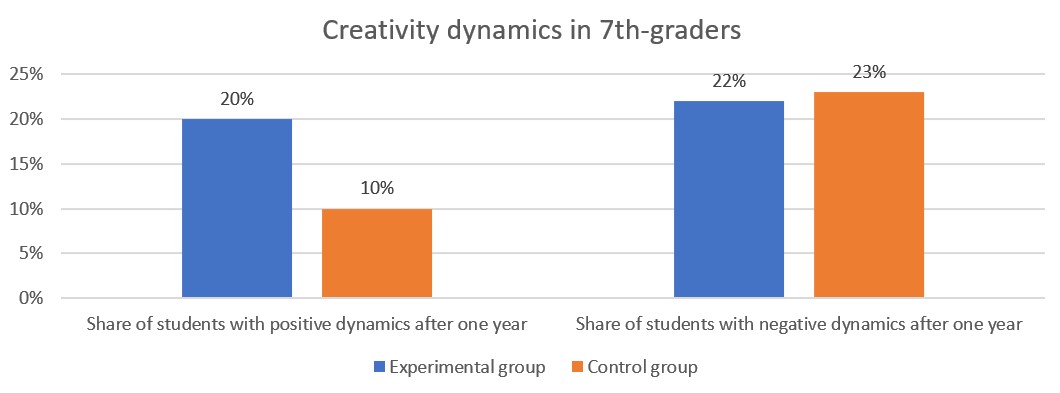
Results of a study carried out in the autumn'2020 – spring'2021 at schools in Kaluga and Yaroslavl Oblasts (Russia). Sample: N=548 7th-graders (145 – from experimental group, 403 – from the control group).
- Conditions that promote motivation and well-being in adolescents
A comparison of three groups of students – under 9 years old (7-8 years old), 9 years old, and over 9 years old (10-11 years old) – showed that as children get older, their productive forms of extrinsic motivation associated with understanding the importance of the subject decreases, while the focus on rewards from a teacher increases. The findings make the search for resources that support adolescents’ intrinsic motivation even more relevant.
Motivation, by age
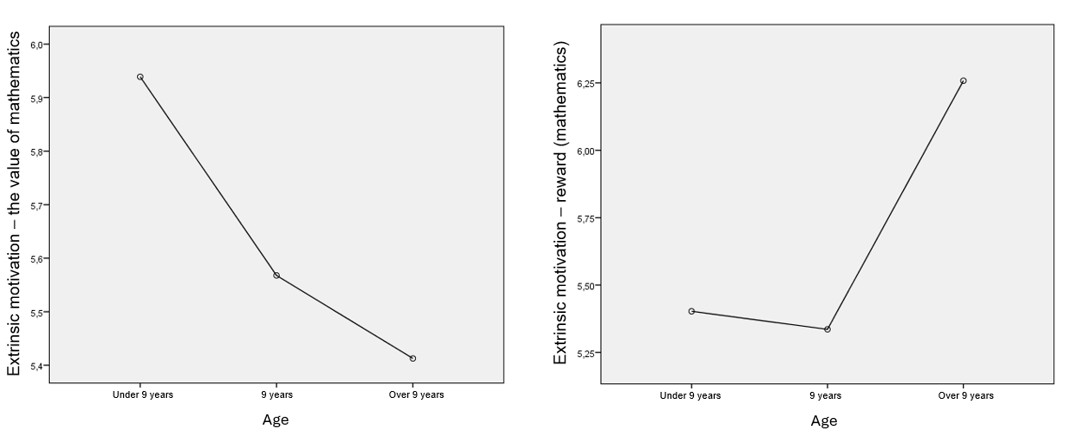
2020 survey results. Sample: N=223 students aged 7-8; 1,402 students aged 9; 65 students aged 10-11. The charts show mean scores. The significant difference by age was identified
The key resource helping maintain the motivation of schoolchildren is the Development of Personality Potential in Adolescents learning kit (PPD kit). Throughout the PPD classes, adolescents learn to be conscious and autonomous, better understand their desires and rely upon themselves in their decision-making - all of which can help them find motivation in learning. Most students show interest in such lessons, but autonomous motivation increases more among those who apply the knowledge and skills in their real life.
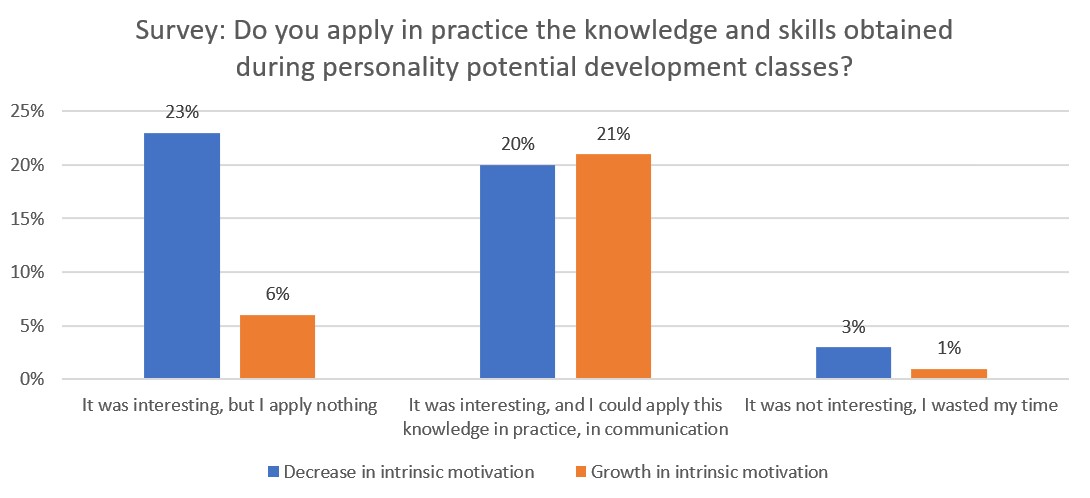
Results of a study carried out in the autumn'2020 – spring'2022. Sample: 83 adolescents who were 5th-graders in 2020 and 7th-graders in 2022
A similar negative dynamic was identified with respect to the psychological well-being of adolescents and the satisfaction of their basic psychological needs, which is related to age specifics. Neutralization of the negative trend up to the increase in well-being is observed in those adolescents who showed interest in PPD classes and were able to apply the acquired knowledge in practice.
*Some links open the Russian version of the website.

